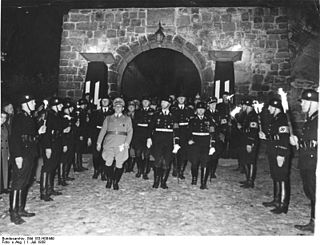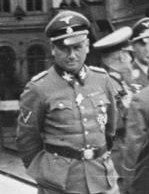Related Research Articles

The Reichskommissariat Ostland (RKO) was established by Nazi Germany in 1941 during World War II. It became the civilian occupation regime in the Baltic states and the western part of the Byelorussian Soviet Socialist Republic. German planning documents initially referred to an equivalent Reichskommissariat Baltenland. The political organization for this territory – after an initial period of military administration before its establishment – involved a German civilian administration, nominally under the authority of the Reich Ministry for the Occupied Eastern Territories led by Nazi ideologist Alfred Rosenberg, but actually controlled by the Nazi official Hinrich Lohse, its appointed Reichskommissar.

Obergruppenführer was one of the Third Reich's paramilitary ranks, first created in 1932 as a rank of the Sturmabteilung (SA), and adopted by the Schutzstaffel (SS) one year later. Until April 1942, it was the highest commissioned SS rank, inferior only to the Reichsführer-SS. Translated as "senior group leader", the rank of Obergruppenführer was senior to Gruppenführer. A similarly named rank of Untergruppenführer existed in the SA from 1929 to 1930 and as a title until 1933. In April 1942, the new rank of SS-Oberst-Gruppenführer was created which was above Obergruppenführer and below Reichsführer-SS.

Reichsführer-SS was a special title and rank that existed between the years of 1925 and 1945 for the commander of the Schutzstaffel (SS). Reichsführer-SS was a title from 1925 to 1933, and from 1934 to 1945 it was the highest rank of the SS. The longest serving and most noteworthy office holder was Heinrich Himmler.

The Allgemeine SS was a major branch of the Schutzstaffel (SS) paramilitary forces of Nazi Germany, and it was managed by the SS Main Office (SS-Hauptamt). The Allgemeine SS was officially established in the autumn of 1934 to distinguish its members from the SS-Verfügungstruppe, which later became the Waffen-SS, and the SS-Totenkopfverbände, which were in charge of the Nazi concentration camps and extermination camps. SS formations committed many war crimes against civilians and allied servicemen.
The title of SS and police leader was used to designate a senior Nazi Party official who commanded large units of the SS, Gestapo and the German uniformed police (Ordnungspolizei), prior to and during World War II.
A Stabsführer served as a deputy to the leader of Hitler Youth, National Socialist Flyers Corps, National Socialist Motor Corps or Sturmabteilung. It was furthermore a Hitler Youth paramilitary rank held by the senior most member of the Adult Leadership Corps.

Friedrich Jeckeln was a German SS commander during the Nazi era. He served as a Higher SS and Police Leader in the occupied Soviet Union during World War II. Jeckeln was the commander of one of the largest collection of Einsatzgruppen death squads and was personally responsible for ordering and organizing the deaths of over 100,000 Jews, Romani, and others designated by the Nazis as "undesirables". After the end of World War II in Europe, Jeckeln was convicted of war crimes by a Soviet military tribunal in Riga and executed in 1946.

Hinrich Lohse was a Nazi German politician and a convicted war criminal, best known for his rule of the Baltic states during World War II.
Units and commands of the Schutzstaffel were organizational titles used by the SS to describe the many groups, forces, and formations that existed within the SS from its inception in 1923 to the eventual fall of Nazi Germany in 1945.
The Allgemeine-SS regional commands comprised the regional Allgemeine-SS units (SS-Oberabschnitt) that were part of the units and commands of the Schutzstaffel (SS) during the Nazi era. The regional commands covered Austria and Germany.
The 11th SS-Standarte was a large regimental formation of the Allgemeine-SS and the principal mustering SS unit in Austria. First formed in 1932, the Standarte was headquartered in Vienna and during its first years of existence served as a base for members of the Austrian SS who were attempting to influence Austrian politics towards an Anschluss with Germany.

SS-Oberabschnitt Böhmen-Mähren was the Allgemeine-SS (General-SS) division command which encompassed the territory of the Protectorate of Bohemia and Moravia. The members of SS units were German Allgemeine-SS members appointed in Bohemia Moravia and Germans born in CSR. The main purpose was propaganda duties and recruiting for the Waffen-SS. The Oberabschnitt had been formed strictly as a General-SS counterpart to the much more powerful position of Higher SS and Police Leader of Moravia and both positions were intended to be held by the same person.

The First SS-Abschnitt was a brigade formation of the Allgemeine-SS and the first such unit ever established in the SS. The First Abschnitt was originally known as the SS-Brigaden 1 and was founded due to an expansion of the SS between 1929 and 1930, causing the need for SS-regiments to be grouped into higher brigade sized formations. The SS-Brigades were modeled after the same type of unit used by the Sturmabteilung.
SS-Oberabschnitt Süd, often translated as "SS-District South" or "SS-Group South", was a division strength command of the Allgemeine-SS and the oldest SS-division in continuous existence from the inception of the SS in the late 1920s to the downfall of Nazi Germany in 1945. One of its most notable commanders was Rudolf Hess who served as an early SS leader after which he was better known as the Deputy Führer of Nazi Germany.

The 17th SS-Standarte was a regimental formation of the Allgemeine-SS first founded in 1931. The unit was one of the early SS formations in Germany, and was first headquartered in the city of Harburg-Wilhelmsburg.
SS-Oberabschnitt Südost was a division command of the Allgemeine-SS which encompassed SS activities in southeastern Germany. The command was first formed in 1932 under the command of Udo von Woyrsch. The first headquarters of the Oberabschnitt was in the city of Brieg. In 1935, the headquarters was transferred to Breslau.

Erwin Schulz was a German member of the Gestapo and the SS in Nazi Germany. He was the leader of Mission squad 5, part of Einsatzgruppe C, which was attached to the Army Group South during the planned invasion of Soviet Union in 1941, and operated in the occupied territories of south-eastern Poland and Ukrainian SSR committing mass killings of civilian population, mostly of Jewish ethnicity, under the command of SS-brigadier general Otto Rasch.
SS-Oberabschnitt Elbe was a division strength command of the Allgemeine-SS which encompassed the General SS-commands of central east Germany, in today what is near to the border of the Czech Republic. During the Second World War, the Oberabschnitt was considered part of War District IV and was under the authority of an SS and Police Leader of the same name. Administratively, the Oberabschnitt leader and the SS and Police commander were typically the same person.
SS-Oberabschnitt Nordwest was a paper command of the Allgemeine-SS which was established in the occupied Netherlands during the Second World War. The position was intended as an administrative counterpart position to the much more powerful office of the Higher SS and Police Leader of the Netherlands and was intended to be held by the same person.
References
- Yerger, Mark C. Allgemeine-SS: The Commands, Units, and Leaders of the General SS, Schiffer Publishing (1997). ISBN 0-7643-0145-4